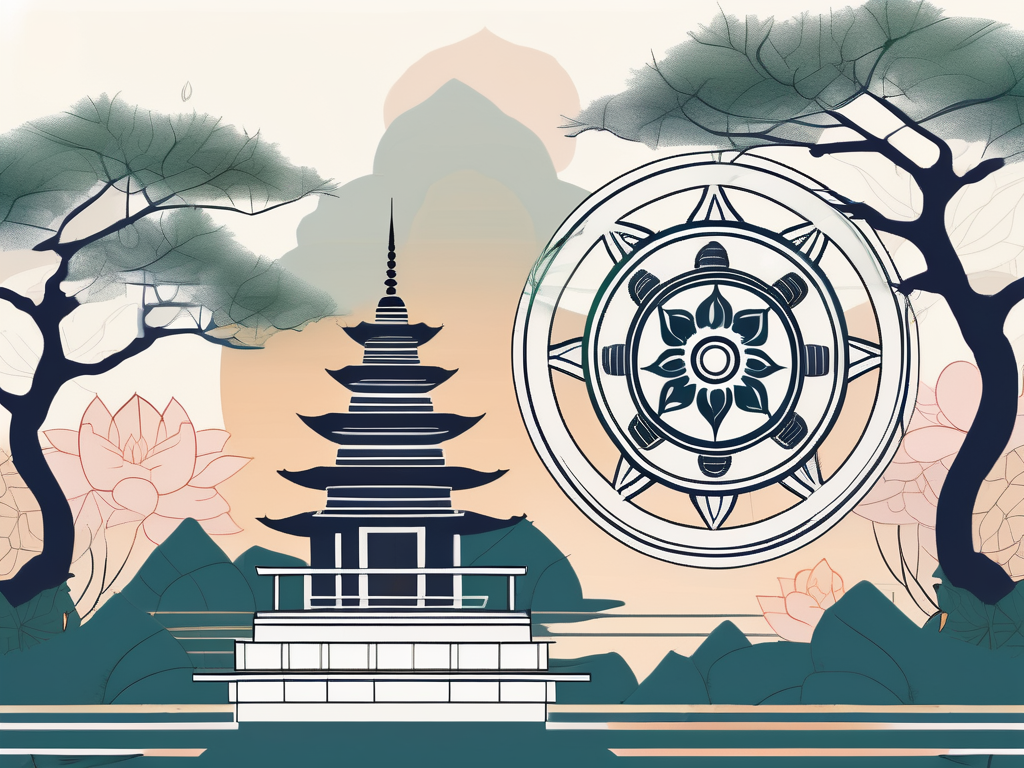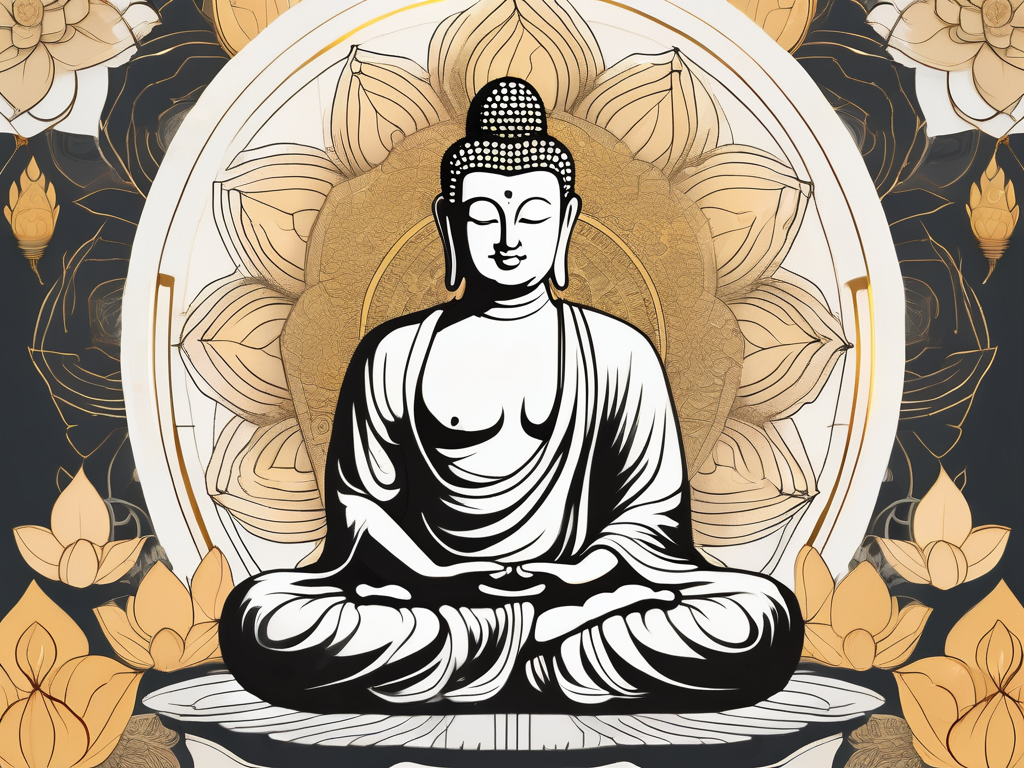Buddha statues are not merely decorative items or religious artifacts. They hold a profound significance that goes beyond their physical representation. Each Buddha statue conveys a rich meaning through its various elements, including the pose, accessories, and cultural context. Understanding these meanings can deepen our appreciation for the beauty and spirituality embodied in these statues.
Understanding the Significance of Buddha Statues
At first glance, Buddha statues may appear serene and peaceful. However, their deeper symbolism relates to the teachings and principles of Buddhism. In Buddhism, the ultimate goal is to attain enlightenment and escape the cycle of rebirth and suffering. Buddha statues serve as a reminder of this noble pursuit and inspire individuals to seek inner peace and enlightenment.
The Role of Buddha Statues in Buddhism
In Buddhism, the Buddha statues act as a focal point for meditation and devotion. They serve as a physical representation of the historical Buddha, Siddhartha Gautama, who achieved enlightenment under the Bodhi tree. Buddha statues help practitioners connect with the guide and inspiration provided by the Buddha’s teachings.
When a practitioner sits in front of a Buddha statue, it serves as a visual aid to focus the mind and cultivate a sense of calm and tranquility. The statue’s serene expression and posture encourage the practitioner to adopt a similar state of mind, allowing for a deeper connection with the teachings of Buddhism.
Moreover, Buddha statues are often placed in temples and meditation halls, creating a sacred space for practitioners to gather and engage in spiritual practices. The presence of the statue enhances the atmosphere, creating an environment conducive to introspection and self-reflection.
The Symbolism of Different Buddha Poses
Buddha statues often depict the Buddha in different poses, each carrying its own symbolic meaning. The most common pose is the meditating or seated Buddha, known as the lotus position. This pose represents serenity, inner strength, and enlightenment.
The lotus position, with crossed legs and hands resting on the lap, signifies the ability to remain grounded and centered amidst the chaos of the world. It reflects the importance of finding stillness and peace within oneself, even in the midst of external challenges and distractions.
Other poses, such as the standing or walking Buddha, signify the active nature of Buddhism and emphasize the importance of compassion and the path towards enlightenment. The standing Buddha, with one hand raised in a gesture of fearlessness, represents the Buddha’s readiness to assist and guide others on their spiritual journey.
The walking Buddha, with one foot forward, symbolizes progress and the continuous effort required to cultivate wisdom and compassion. It reminds practitioners that the path to enlightenment is not stagnant but rather a lifelong journey of growth and self-improvement.
Overall, Buddha statues serve as powerful visual representations of the core principles and teachings of Buddhism. They inspire individuals to embark on their own spiritual journey, seeking inner peace, enlightenment, and liberation from suffering.
The History and Evolution of Buddha Statues
Buddha statues have a rich history that spans thousands of years. Originating in ancient India, they have evolved and adapted to different cultures and artistic traditions over time. Understanding the historical context of Buddha statues can provide valuable insights into their symbolism and artistic significance.
The story of Buddha statues begins in the 1st century CE when Buddhism started to spread across Asia. As the teachings of Buddhism reached new lands, so did the need for visual representations of the enlightened one. The earliest Buddha statues adhered to the Gandharan style, a fusion of Greco-Buddhist art. These statues depicted the Buddha with distinct Hellenistic features, such as wavy hair and a toga-like robe.
Over time, different regions developed their unique styles, incorporating local traditions and cultural influences into their depictions of the Buddha. In India, the birthplace of Buddhism, statues were often carved out of stone and displayed in ancient monasteries and sacred sites. The Gupta period, known as the Golden Age of Indian art, saw the emergence of exquisite Buddha statues characterized by graceful proportions and serene expressions.
Origin and Early Depictions of Buddha Statues
The earliest Buddha statues can be traced back to the 1st century CE when Buddhism started to spread across Asia. These statues adhered to the Gandharan style and depicted the Buddha in a Greco-Buddhist art fusion. Over time, different regions developed their unique styles, incorporating local traditions and cultural influences into their depictions of the Buddha.
In Central Asia, the influence of the Silk Road brought about a blend of Indian and Chinese artistic elements in Buddha statues. These statues often featured intricate details and elaborate drapery, reflecting the cultural exchange along the ancient trade routes. In the region of Gandhara, which encompasses parts of present-day Pakistan and Afghanistan, Buddha statues were characterized by a blend of Indian and Hellenistic styles, with the Buddha depicted in a seated or standing position.
As Buddhism spread further east, reaching China, Korea, and Japan, Buddha statues underwent further transformations. In China, the statues took on a more sinicized appearance, with the Buddha depicted with more rounded facial features and a serene expression. The Tang dynasty saw the rise of the “Maitreya Buddha,” a representation of the future Buddha, often depicted with a smiling face and a rotund figure.
Evolution of Buddha Statues Across Different Cultures
As Buddhism spread throughout Asia, Buddha statues took on diverse forms, reflecting the artistic traditions of different regions. For example, in East Asia, statues often portray the Buddha with more rounded facial features and a serene expression. In Southeast Asia, Buddha statues exhibit distinctive characteristics, including elongated earlobes and intricate detailing.
In Japan, the Kamakura period marked a significant shift in the portrayal of Buddha statues. The introduction of Zen Buddhism led to the creation of statues that emphasized simplicity and naturalness. These statues, known as “Zenkō-ji,” were often made of wood and featured a meditative expression, capturing the essence of Zen philosophy.
Throughout history, Buddha statues have not only served as religious icons but also as artistic masterpieces. The craftsmanship and attention to detail in these statues reflect the devotion and reverence towards the Buddha. From the ancient Gandharan style to the diverse representations found across Asia, Buddha statues continue to inspire awe and admiration for their historical and artistic significance.
The Artistry and Craftsmanship of Buddha Statues
Buddha statues are not just religious statues; they are also works of art that showcase the skill and craftsmanship of the artisans who create them. The materials and techniques used in their creation contribute to their aesthetic appeal and spiritual resonance.
When it comes to creating Buddha statues, artisans employ a wide range of materials, each with its own unique significance. Wood, for example, is often used for its natural warmth and organic feel. The grain of the wood adds depth and texture to the statue, enhancing its overall beauty. Stone, on the other hand, offers a sense of permanence and solidity. The cool touch of stone evokes a sense of tranquility and stability, qualities often associated with Buddha himself.
For those seeking a touch of opulence, metal statues are a popular choice. Crafted from bronze, copper, or gold, these statues shimmer and shine, catching the light and drawing the eye. The use of precious gems, such as sapphires, rubies, or diamonds, adds a touch of luxury and grandeur to the statue, elevating it to a whole new level of artistry.
Regardless of the material used, skilled artisans employ specific crafting techniques to bring the Buddha statue to life. Carving is a common technique used with wood and stone statues. The artisan carefully chisels away at the material, shaping it into the desired form. The process requires patience and precision, as even the smallest details can make a significant difference in the final result.
Casting is another technique used in Buddha statue creation. This involves creating a mold of the desired statue and pouring molten metal into it. Once the metal cools and solidifies, the mold is removed, revealing the finished statue. This method allows for intricate details and complex designs to be replicated with ease.
Molding is yet another technique employed by artisans. This involves creating a mold from a pliable material, such as clay or wax, and then pouring a liquid material, such as bronze, into the mold. Once the liquid material hardens, the mold is removed, leaving behind a solid statue. This technique allows for greater flexibility in design and can result in statues with intricate patterns and textures.
The Aesthetics of Buddha Statues: Beyond the Spiritual
Beyond their spiritual significance, Buddha statues are admired for their aesthetic qualities. The meticulous attention to detail, harmonious proportions, and serene expressions all contribute to their beauty. These statues engage not only the spiritual senses but also the artistic sensibilities of individuals who appreciate their visual appeal.
When it comes to the aesthetics of Buddha statues, every element is carefully considered. The proportions of the statue are meticulously calculated to create a sense of balance and harmony. The serene expressions on the faces of the statues evoke a sense of inner peace and tranquility, inviting viewers to find solace in their presence.
The intricate details found on Buddha statues are a testament to the skill and artistry of the artisans. From the delicate folds of the robes to the intricate patterns on the base, every aspect is crafted with precision and care. These details not only enhance the visual appeal of the statue but also add depth and meaning to its overall symbolism.
Furthermore, the choice of colors used in Buddha statues can have a significant impact on their aesthetic appeal. Soft, earthy tones are often employed to create a sense of warmth and serenity, while vibrant hues can evoke a sense of energy and vitality. The careful selection and application of colors add another layer of artistic expression to the statue.
Overall, Buddha statues are not just religious artifacts; they are masterpieces of art and craftsmanship. The materials, techniques, and aesthetics all come together to create statues that transcend their religious significance and captivate the hearts and minds of those who appreciate their beauty.
Interpreting Buddha Statues: A Guide
Interpreting the symbolism behind Buddha statues is an art in itself. To fully appreciate the meanings behind these statues, it is essential to understand the gestures, postures, and accessories commonly depicted.
When examining a Buddha statue, one of the first things to observe is the hand gestures, known as mudras. These mudras carry deep symbolic meanings that reflect different aspects of the Buddha’s teachings and virtues. For example, the Abhaya Mudra, or the gesture of fearlessness, is often depicted with the right hand raised and palm facing outwards. This mudra represents protection and reassurance, reminding the viewer to have courage and trust in the path of enlightenment.
Another commonly seen mudra is the Dhyana Mudra, also known as the meditation gesture. In this posture, the Buddha is depicted with both hands resting on the lap, right hand over the left, palms facing upwards. This mudra symbolizes deep concentration and inner peace, reminding the viewer of the importance of mindfulness and meditation in the pursuit of enlightenment.
Aside from hand gestures, Buddha statues may also feature various accessories that hold their own significance. One such accessory is the crown, which represents the Buddha’s enlightenment and spiritual authority. The intricately designed crowns often depict different symbols and motifs, reflecting the cultural and historical context in which the statue was created.
Robes are another accessory commonly seen on Buddha statues. These robes symbolize simplicity and renunciation of worldly desires. The way the robes are draped and the patterns they bear can provide insights into the specific Buddhist tradition or region the statue belongs to.
Jewels are yet another accessory that can be found on Buddha statues. These jewels represent spiritual wealth and the treasures of enlightenment. They serve as a reminder of the abundance that comes from following the Buddha’s teachings and attaining inner peace.
By paying attention to these gestures and accessories, one can gain a deeper understanding of the stories and teachings associated with a Buddha statue. Each element adds depth and narrative to the visual representation, inviting the viewer to explore the rich symbolism and profound wisdom encapsulated within.
The Role of Buddha Statues in Modern Spirituality
Buddha statues continue to hold significance in modern times, extending beyond Buddhism itself. Their universal message of peace, mindfulness, and compassion resonates with people from diverse cultures and spiritual backgrounds.
Buddha Statues in Non-Buddhist Cultures
Buddha statues have transcended their Buddhist origins and become objects of inspiration in various non-Buddhist cultures. People display Buddha statues in their homes, gardens, and meditation spaces, seeking the tranquility and serenity associated with these statues.
Buddha Statues as Symbols of Peace and Mindfulness
In today’s fast-paced world, Buddha statues serve as powerful reminders to slow down, find inner peace, and cultivate mindfulness. Their presence in public spaces, such as parks or institutions, creates an atmosphere of serenity and offers solace to those seeking respite from the chaos of everyday life.
In conclusion, Buddha statues carry a multitude of meanings that span cultural, historical, and spiritual contexts. They are not mere decorative items but representations of ancient wisdom and the human quest for enlightenment. By understanding the significance behind Buddha statues, we can gain deeper insights into the beauty and spirituality embodied in these timeless artworks.












